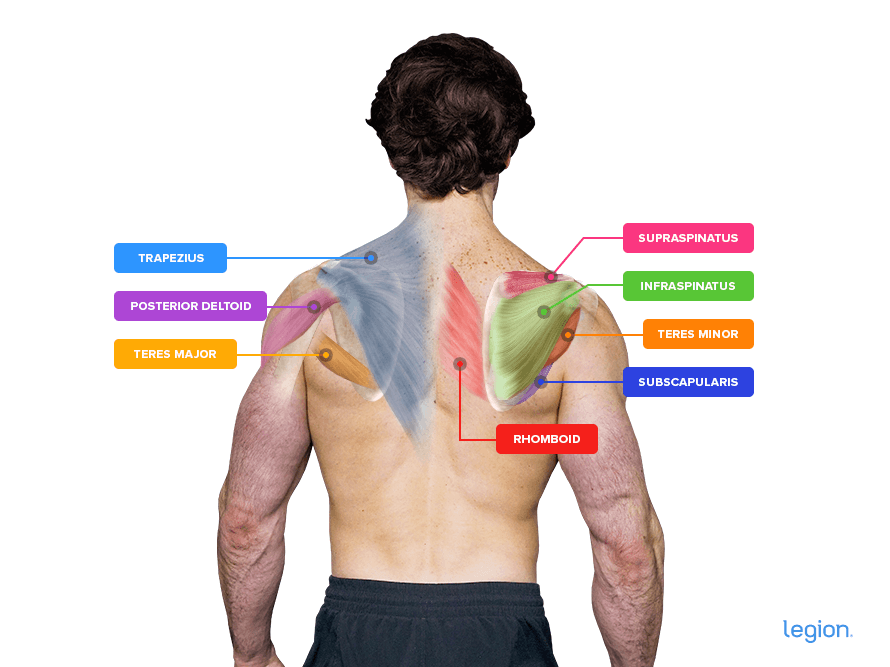Band pull-aparts are an excellent upper back and shoulder exercise that too few people do.
While they appear simple, they’re highly beneficial for improving posture, bolstering shoulder health, enhancing scapular control, warming up several upper body muscles, and facilitating shoulder injury recovery.
In this article, you’ll learn what resistance band pull-aparts are, why they’re advantageous, which muscles they work, how to do them with proper form, the best band pull-apart alternatives and variations, and more.
What Are Band Pull Aparts?
The band pull-apart is a resistance band exercise that primarily trains your shoulders and upper back muscles.
To perform the resistance band pull apart, hold a resistance band at arms’ length in front of your chest with a shoulder-width grip and move your hands away from each other until your upper arms are out to your sides.
The Benefits of Banded Pull Aparts
1. They may improve your posture.
Band pull-aparts work the rhomboids and trapezius muscles, which are key for maintaining good posture. Strengthening these muscles can help counteract the effects of sitting at a desk all day, which often leads to rounded shoulders and a forward head position.
2. They improve shoulder health.
The banded pull-apart helps improve the stability of the shoulder joint by strengthening the rotator cuff muscles. These muscles are crucial for almost all upper body movements, and stronger rotator cuff muscles can reduce your risk of shoulder injuries.
3. They help you learn how to retract and depress your scapula.
Band pull-aparts help you learn to pull your shoulder blades together (scapular retraction) and keep them down (scapular depression), which is essential for maximizing muscle growth during “pulling” exercises and stabilizing your shoulders during flat “pushing” exercises, like the bench press, dumbbell bench press, and dip.
4. They’re an effective warm-up exercise.
Band pull-aparts are excellent for “switching on” the upper back muscles before heavy weightlifting workouts, serving as a great warm-up exercise to prevent injury and enhance performance.
5. They’re effective for injury rehabilitation.
Because band pull-aparts are low-impact and allow you to use light resistance, weightlifters often use them to gradually build shoulder strength when coming back after an injury.
Band Pull Aparts: Muscles Worked
The banded pull-apart trains all upper back and shoulder muscles.
Specifically, the main muscles worked by band pull-aparts are the . . .
- Trapezius
- Posterior (“rear”) deltoid
- Teres major and minor
- Infraspinatus
- Supraspinatus
- Subscapularis
- Rhomboids
Here’s how they look on your body:

How to Do Band Pull-Aparts With Proper Form
To master the band pull-apart exercise, split it into three parts: set up, pull apart, and protract.
1. Set up
Stand upright with your feet shoulder-width apart. Hold a light resistance band at arms’ length in front of your chest with a shoulder-width grip and your palms facing the floor.
Adjust your grip so there’s tension in the band when your hands are shoulder-width apart.
2. Pull apart
Move your hands away from each other until your arms are directly out to your sides and the band touches your chest. As you pull the band apart, squeeze your shoulder blades together.
3. Protract
Reverse the movement and return to the starting position.
Here’s how it should look when you put everything together:
The Best Band Pull-Apart Alternatives and Variations
1. Supinated Band Pull Apart
In the supinated band pull apart, your palms face the ceiling, shifting some of the emphasis from your upper traps and rear delts to your infraspinatus and lower traps.
2. Overhead Band Pull Apart
In the overhead band pull-apart, you pull the band apart through a different range of motion to the regular pull apart, making the overhead version a useful band pull-apart variation for developing all-around scapular control and rotator cuff strength.
3. Bent-Over Band Pull Apart
Performing the resistance band pull-apart while bent over mimics the starting position of exercises like the barbell, T-bar, and Pendlay row, allowing you to practice retracting and depressing your scapular while “hinging” forward.
4. Band Face Pull
As well as training the muscles responsible for pulling horizontally toward your face, the band face pull strengthens the shoulder muscles that rotate your arm upward, making the face pull an excellent band pull-apart alternative.
5. Dumbbell Rear Delt Fly
The dumbbell rear delt fly effectively trains the rear delts, traps, and rhomboids, making it a viable band pull-apart alternative if you only have access to dumbbells.
Scientific References +
- Kolber, Morey J., et al. “Characteristics of Shoulder Impingement in the Recreational Weight-Training Population.” The Journal of Strength & Conditioning Research, vol. 28, no. 4, 1 Apr. 2014, pp. 1081–1089, journals.lww.com/nsca-jscr/FullText/2014/04000/Characteristics_of_Shoulder_Impingement_in_the.28.aspx, https://doi.org/10.1519/JSC.0000000000000250.
- Fukunaga, Takumi, et al. “Band Pull-Apart Exercise: Effects of Movement Direction and Hand Position on Shoulder Muscle Activity.” International Journal of Sports Physical Therapy, vol. 17, no. 3, 2 Apr. 2022, https://doi.org/10.26603/001c.33026. Accessed 1 May 2022.










